United States Agricultural Irrigation Machinery Market Size
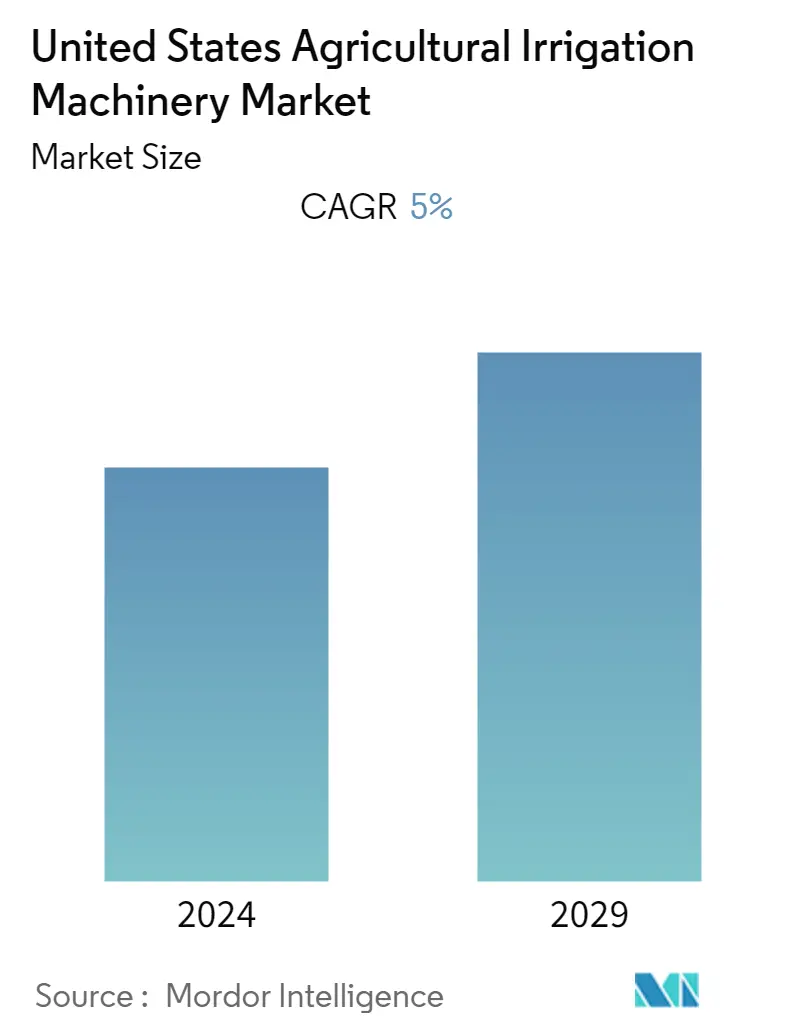
| Study Period | 2019 - 2029 |
| Base Year For Estimation | 2023 |
| Forecast Data Period | 2024 - 2029 |
| Historical Data Period | 2019 - 2022 |
| CAGR | 5.00 % |
| Market Concentration | High |
Major Players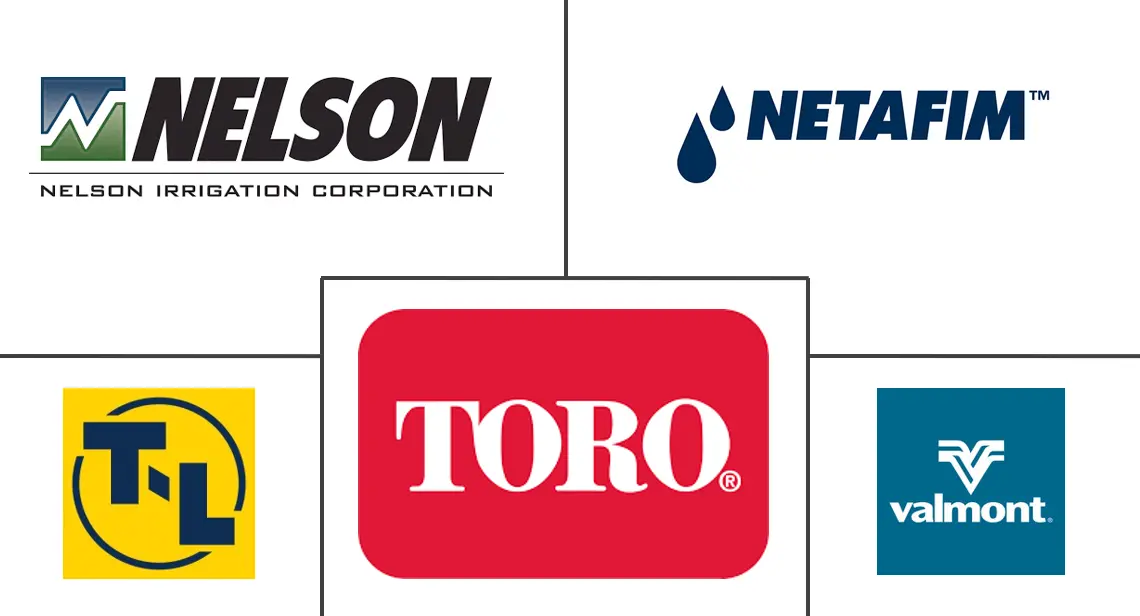
*Disclaimer: Major Players sorted in no particular order |
United States Agricultural Irrigation Machinery Market Analysis
The United States agricultural irrigation machinery market is projected to register a CAGR of 5.0% during the forecast period.
- Growing urban populations and economic development intensify competition for the nation's water resources. With surface water supplies largely allocated in most river basins of the Western United States and some river basins in the Eastern United States, emerging water demands from non-agricultural sectors must be met in many cases through a reallocation of water initially allocated to agriculture. The adoption rate of irrigation systems has increased over the past few years in the United States, with micro irrigation dominating the Pacific and sprinkler irrigation dominating the mountains and plains. Installing them minimizes soil erosion and increases crop yield with high quality and low weed growth.
- Irrigation has significantly enhanced both the productivity and profitability of the agricultural sector. According to the United States Department of Agriculture - National Agricultural Statistics Service Information (USDA-NASS) Report, 2019, irrigated farms accounted for more than 54 percent of the total value of the US crop sales on less than 30 percent of harvested cropland.
- Generally, irrigation increases crop yields and reduces yield risk while providing other potential benefits involving nutrient uptake efficiency, crop quality control, and frost protection. Irrigated crop production supports local rural economies in many areas of the United States and contributes significantly to the US livestock, food processing, transportation, and energy sectors.
- In many areas of the Pacific, mountain, and southern and northern plains regions, precipitation is insufficient to meet the water requirements of most crops, and irrigation is necessary for agricultural production. In other more humid regions, annual and seasonal variation in the amount and timing of rainfall drives irrigation adoption decisions.
- The availability of surface and groundwater is also a primary factor in the spatial distribution of irrigation. Much of the irrigation development in the West was made possible through publicly financed investments in surface water storage and conveyance projects. In the plains regions, concentrations of irrigated areas largely reflect the availability of groundwater resources, specifically the high plains aquifer (Ogallala Aquifer).
United States Agricultural Irrigation Machinery Market Trends
Increasing Awareness of Micro-irrigation
- The irrigation systems market is primarily driven by factors such as the need to increase crop productivity while addressing water scarcity issues. Thus, governments in various regions are focusing on formulating initiatives to increase the usage of irrigation systems, such as drip, sprinkler, and pivot, while limiting water shortage.
- With water increasingly becoming a scarce commodity, farmers have been seeking novel ideas to grow more crops with the same quantity of water. Irrigation systems, including sprinklers, and drippers, are witnessing high demand. This is expected to augment the growth of the market studied.
- The agricultural sector is the predominant consumer of water. Water scarcity is a major challenge and a key driver for using micro-irrigation machinery systems. Micro irrigation systems such as drip and sprinklers reduce water wastage and increase productivity. There has been an increasing awareness about the benefits achieved by adopting micro irrigation systems among farmers. Hence, the shift from gravity irrigation systems to pressure-sprinkler irrigation systems has been observed, particularly in the country's western states.
- Approximately 58 million acres of land have been irrigated using micro irrigation systems in the United States. Moreover, increasing technological advancements in micro irrigation systems offer ubiquitous ease to large farmers in the agricultural sector to control and monitor the water flow and intake of plants, which favors market growth.
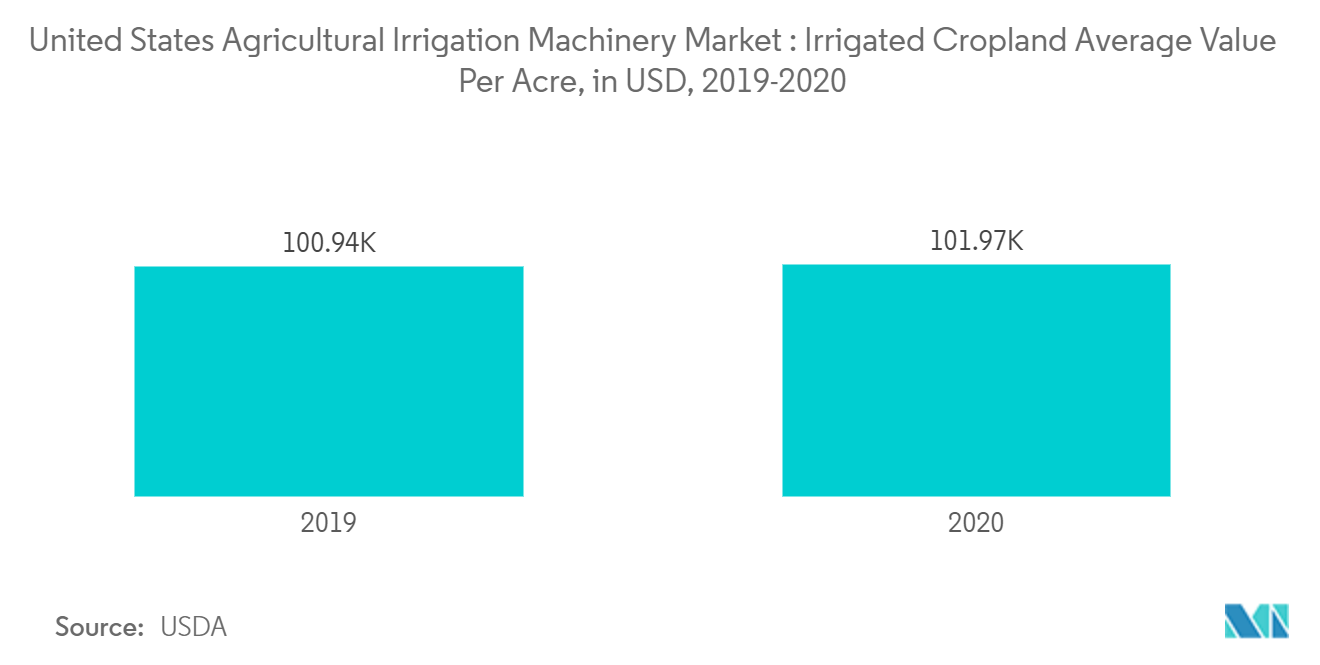
California Dominates the Market in Terms of Irrigation System
- Irrigation predominantly occurs in the Western parts of the United States. The western states accounted for 81% of the total irrigation withdrawals and had 74% of the total irrigated lands in the United States. California ranks first among highly irrigated acres of land, constituting nearly 7.9 million acres.
- About 82% of the cropland is irrigated, and the most irrigated acres by crop are corn, forage (hay, silage, etc.), and orchards. The primary irrigation method is gravity, accounting for 51%, followed by 31% micro-irrigation and the remaining 18% by sprinkler irrigation. Therefore, there will be an increasing demand for the agricultural irrigation machinery market, particularly in the Western region of the United States.
- Irrigation wells typically have higher capacity and pump more groundwater than domestic wells to provide water to farms that feed millions of people throughout California and the world. Over the last five years, 6,757 irrigation wells have been installed across the state compared to the 58,845 total number of irrigation wells installed till the current year. The year-to-year number of new irrigation wells has fluctuated from a low of 1,033 in 2018 to a high of 1,626 in 2021.
- New irrigation wells installed in California are much more concentrated than domestic wells. Within the last water year, Tulare County (440) installed more new irrigation wells than any other county in the state, accounting for approximately one out of every six (17 percent), which will boost the demand for irrigation systems in the province in coming years.
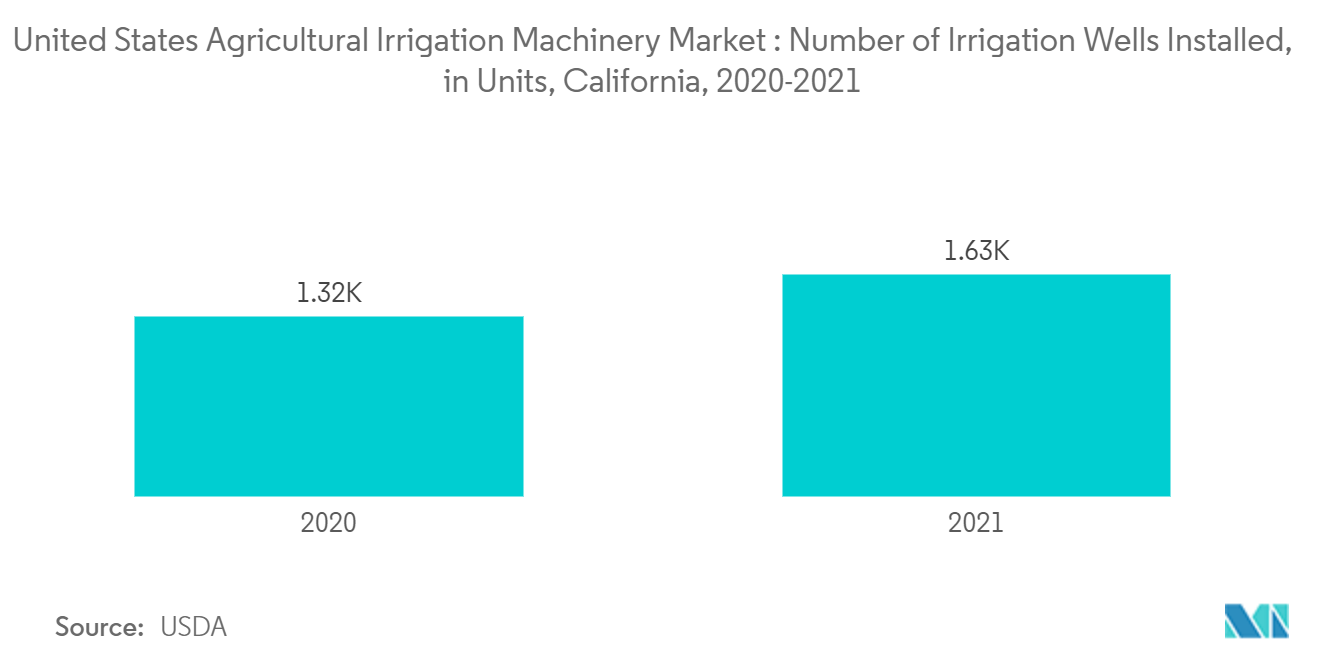
United States Agricultural Irrigation Machinery Industry Overview
The United States agricultural irrigation machinery market is consolidated with a few major players competing. The major players include Nelson Irrigation Corporation, Netafim, Jain Irrigation, Inc., T.L. Irrigation Co., the Toro Company, Valmont Industries, Inc., Rain Bird Corporation, and Rivulis. New product launches, partnerships, and acquisitions are the major strategies adopted by the leading companies in the market in the country. Along with innovations and expansions, investments in R&D and developing novel product portfolios will likely be crucial strategies in the coming years.
United States Agricultural Irrigation Machinery Market Leaders
-
Nelson Irrigation Corporation
-
Netafim USA
-
T-L Irrigation Co.
-
Valmont Industries, Inc.
-
The Toro Company
*Disclaimer: Major Players sorted in no particular order
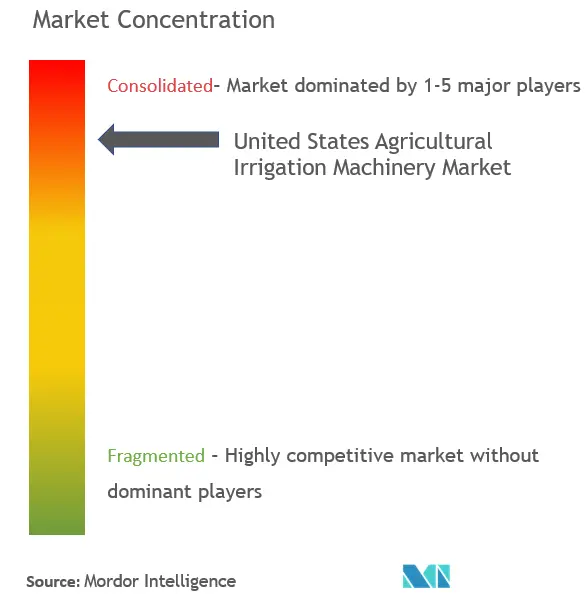
United States Agricultural Irrigation Machinery Market News
- November 2022: Jain Irrigation, Inc. acquired SWIIM assets, including the leading water management IP/technology portfolio and know-how, certain field hardware for water management services, access to new markets and customers, and current contracts for OnFarm Water Accounting. This acquisition continues its progression as the leading technology consolidator in Irrigation and Ag Technology.
- January 2022: Netafim USA collaborated with Bayer to create the Precise Defense program. Precise Defense delivers a powerful one-two punch by utilizing Netafim's precision drip irrigation technology to deliver Velum One Nematicide and other crop protection products directly to the root zone.
- January 2020: Lindsay Corporation collaborated with Farmers Edge to integrate digital platforms to provide their growers and dealer networks with a first-of-its-kind, fully connected crop management solution. The expanded partnership will also focus on collaborating in data science, machine learning, and artificial intelligence (AI)-driven analytics to deliver highly precise water-based insights and predictive models, setting a new standard in agriculture.
United States Agricultural Irrigation Machinery Market Report - Table of Contents
1. INTRODUCTION
- 1.1 Study Assumptions & Market Definition
- 1.2 Scope of the Study
2. RESEARCH METHODOLOGY
3. EXECUTIVE SUMMARY
4. MARKET DYNAMICS
- 4.1 Market Overview
- 4.2 Market Drivers
- 4.3 Market Restraints
-
4.4 Porter's Five Forces Analysis
- 4.4.1 Bargaining Power of Suppliers
- 4.4.2 Bargaining Power of Buyers
- 4.4.3 Threat of New Entrants
- 4.4.4 Threat of Substitutes
- 4.4.5 Intensity of Competitive Rivalry
5. MARKET SEGMENTATION
-
5.1 Irrigation Type
- 5.1.1 Sprinkler Irrigation
- 5.1.2 Drip Irrigation
- 5.1.3 Pivot Irrigation
- 5.1.4 Other Irrigation Types
-
5.2 Application
- 5.2.1 Crop Based
- 5.2.2 Non-Crop Based
6. COMPETITIVE LANDSCAPE
- 6.1 Most Adopted Strategies
- 6.2 Market Share Analysis
-
6.3 Company Profiles
- 6.3.1 Nelson Irrigation Corporation
- 6.3.2 Netafim USA
- 6.3.3 Jain Irrigation, Inc.
- 6.3.4 T-L Irrigation Co.
- 6.3.5 The Toro Company
- 6.3.6 Valmont Industries, Inc.
- 6.3.7 Lindsay Corporation
- 6.3.8 Deere & Company
- 6.3.9 Rivulis Irrigation Ltd
- 6.3.10 Rain Bird Corporation
- *List Not Exhaustive
7. MARKET OPPORTUNITIES AND FUTURE TRENDS
** Subject To AvailablityUnited States Agricultural Irrigation Machinery Industry Segmentation
Agricultural irrigation machinery is a system that distributes water under low pressure through a piped network and applies it as a small discharge to each plant. Micro-irrigation uses less pressure and water flow than sprinkler irrigation. Drip irrigation delivers water directly to the root zone of plants. The United States agricultural irrigation machinery market is segmented by irrigation type into sprinkler irrigation, drip irrigation, pivot irrigation, and other irrigation types and application into crop and non-crop. The report offers the market size and forecasts for volume in (units) and value in (USD million) for all the above segments.
| Irrigation Type | Sprinkler Irrigation |
| Drip Irrigation | |
| Pivot Irrigation | |
| Other Irrigation Types | |
| Application | Crop Based |
| Non-Crop Based |
United States Agricultural Irrigation Machinery Market Research FAQs
What is the current United States Agricultural Irrigation Machinery Market size?
The United States Agricultural Irrigation Machinery Market is projected to register a CAGR of 5% during the forecast period (2024-2029)
Who are the key players in United States Agricultural Irrigation Machinery Market?
Nelson Irrigation Corporation, Netafim USA, T-L Irrigation Co., Valmont Industries, Inc. and The Toro Company are the major companies operating in the United States Agricultural Irrigation Machinery Market.
What years does this United States Agricultural Irrigation Machinery Market cover?
The report covers the United States Agricultural Irrigation Machinery Market historical market size for years: 2019, 2020, 2021, 2022 and 2023. The report also forecasts the United States Agricultural Irrigation Machinery Market size for years: 2024, 2025, 2026, 2027, 2028 and 2029.
United States Agricultural Irrigation Machinery Industry Report
Statistics for the 2024 United States Agricultural Irrigation Machinery market share, size and revenue growth rate, created by Mordor Intelligence™ Industry Reports. United States Agricultural Irrigation Machinery analysis includes a market forecast outlook to 2029 and historical overview. Get a sample of this industry analysis as a free report PDF download.



